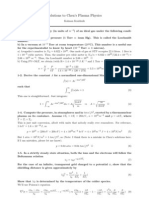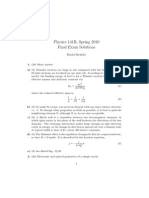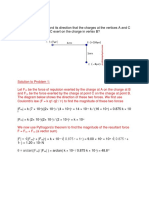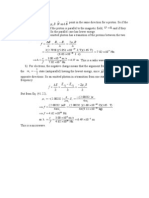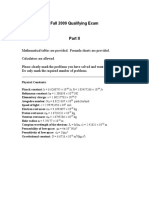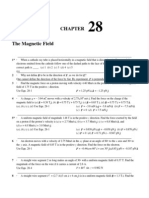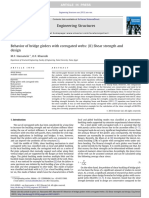CH29
CH29
Uploaded by
John Paolo MirandaCopyright:
Available Formats
CH29
CH29
Uploaded by
John Paolo MirandaOriginal Description:
Copyright
Available Formats
Share this document
Did you find this document useful?
Is this content inappropriate?
Copyright:
Available Formats
CH29
CH29
Uploaded by
John Paolo MirandaCopyright:
Available Formats
CHAPTER 29
THE MAGNETIC FIELD
Problem
1.
(a) What is the minimum magnetic field needed to exert a 5.4 10 15 -N force on an electron moving at 2.1 10 7 m/s ?
(b) What magnetic field strength would be required if the field were at 45 to the electrons velocity?
Solution
(a) From Equation 29-1b, B = F=ev sin , which is a minimum when sin = 1 (the magnetic field perpendicular to the
velocity). Thus, Bmin = (5.4 10 15 N )=(1.6 10 19 C)(2.1 10 7 m/s) = 1.61 10 3 T = 16.1 G. (b) For = 45 ,
B = Bmin =sin 45 = 2 Bmin = 22.7 G.
Problem
3.
What is the magnitude of the magnetic force on a proton moving at 2.5 10 5 m/s (a) at right angles; (b) at 30;
(c) parallel to a magnetic field of 0.50 T?
Solution
From Equation 29-1b, F = evB sin , so (a) when = 90, F = (1.6 10 19 C)(2.5 10 5 m/s)(0.5 T ) = 2.0 10 14 N,
(b) F = (2.0 10 14 N ) sin 30 = 1.0 10 14 N, and (c) F = evB sin 0 = 0.
Problem
5.
A particle carrying a 50- C charge moves with velocity v = 5.0 + 3.2k m/s through a uniform magnetic field
B = 9.4 + 6.7j T. (a) What is the force on the particle? (b) Form the dot products F v and F B to show explicitly that
the force is perpendicular to both v and B.
Solution
(a) From Equation 27-2, F = qv B = (50 C)(5 + 3.2k m/s) (9.4 + 6.7j T) = (50 10 6 N)(5 6.7k + 3.2 9.4 j
3.2 6.7 ) = ( 1.072 + 1.504 j + 1.675k ) 10 3 N. (The magnitude and direction can be found from the components, if
desired.) (b) The dot products F v and F B are, respectively, proportional to ( 1.072)(5) + (1.675)(3.2) = 0, and
( 1.072 )(9.4) + (1.504 )(6.7) = 0, since the cross product of two vectors is perpendicular to each factor. (We did not round off
the components of F, so that the vanishing of the dot products could be exactly confirmed.)
Problem
6.
Moving in the x direction, a particle carrying 1.0 C experiences no force. Moving with speed v at 30 to the x axis, the
particle experiences a magnetic force of 2.0 N. What magnetic force would it experience if it moved along the y axis with
speed v?
Solution
We assume that the forces mentioned are due only to the presence of a magnetic field, which is uniform in the region of space
considered. The first condition requires that the field be in the x direction, since F1 = qv B = 0, implies that
( Bx + By j + Bz k ) = By k Bz j = 0, or By = 0 = Bz . The second condition requires that the magnitude of the field
satisfies the equation 2 N = F2 = qvB sin 30 , or qvB = 4 N. Therefore, the force on the particle, when its velocity is
v j, is F3 = qvj B = qvBk = ( 4 N)k .
Problem
8.
The magnitude of Earths magnetic field is a little less than 1 G near Earths surface. What is the maximum possible
magnetic force on an electron with kinetic energy of 1 keV? Compare with the gravitational force on the same electron.
684 CHAPTER 29
Solution
An electron, moving perpendicularly to the Earths magnetic field near the surface, experiences a maximum magnetic force of
evB = eB 2 K /m ' (1.6 10 19 C)(10 4 T) 2(10 3 eV)(1.6 10 19 J/eV)=(9.11 10 31 kg) ' 3 10 16 N. The weight of
an electron near the Earths surface is mg = (9.11 10 31 kg)(9.8 m/s 2 ) ' 9 10 30 N, a factor of nearly 3 10 14 times
smaller.
Problem
11. A 1.4- C charge moving at 185 m/s experiences a magnetic force FB = 2.5 + 7.0 j N in a magnetic field
B = 42 15j mT. What is the angle between the particles velocity and the magnetic field?
Solution
Equation 29-1b gives sin = F=qvB = (2.5 2 ) + ( 7.0 ) 2 N (1.4 C)(185 m/s) ( 42 2 ) + ( 15) 2 mT = 0.644. Then
= 40.1 or 140 (both are possible since sin = sin(180 )).
Problem
13. A region contains an electric field E = 7.4 + 2.8j kN/C and a magnetic field B = 15j + 36k mT. Find the
electromagnetic force on (a) a stationary proton, (b) an electron moving with velocity v = 6.1 Mm/s.
Solution
The force on a moving charge is given by Equation 29-2 (called the Lorentz force) F = q(E + v B). (a) For a stationary
proton, q = e and v = 0, so F = eE = (1.6 10 19 C)(7.4 + 2.8j ) kN/C = (1.18 + 0.448j ) fN. (b) For the electron,
q = e and v = 6.1 Mm/s, so the electric force is the negative of the force in part (a) and the magnetic force is
ev B = ( 1.6 10 19 C)(6.1 Mm/s) (15j + 36k ) mT = ( 14.6k + 35.1j ) fN. The total Lorentz force is the sum of these,
or ( 118
. + 34.7j 14.6k ) fN.
Problem
15. What is the radius of the circular path described by a proton moving at 15 km/s in a plane perpendicular to a 400-G
magnetic field?
Solution
From Equation 29-3, the radius of the orbit is r = mv=eB = (1.67 10 27 kg)(15 km/s)=(1.6 10 19 C)( 4 10 2 T) =
3.91 mm. (SI units and data for the proton are summarized in the appendices and inside front cover.)
Problem
16. How long does it take an electron to complete a circular orbit at right angles to a 1.0-G magnetic field?
Solution
Equation 29-4 gives a period of T = 2 m=eB = 2 (9.11 10 31 kg) (1.6 10 19 C)(10 4 T ) = 358 ns.
Problem
17. Radio astronomers detect electromagnetic radiation at a frequency of 42 MHz from an interstellar gas cloud. If this
radiation is caused by electrons spiraling in a magnetic field, what is the field strength in the gas cloud?
Solution
If this is electromagnetic radiation at the electrons cyclotron frequency, Equation 29-5 implies a field strength of
CHAPTER 29 685
B = 2 f ( m=e) = 2 ( 42 MHz)(9.11 10 31 kg=1.6 10 19 C) = 1.50 10 3 T = 15.0 G.
Problem
19. Electrons and protons with the same kinetic energy are moving at right angles to a uniform magnetic field. How do their
orbital radii compare?
Solution
It is convenient to anticipate the result of Problem 22 for the orbital radius of a non-relativistic charged particle in a plane
perpendicular to a uniform magnetic field. From Equation 29-3, r = mv=qB. For a non-relativistic particle, K = 12 mv 2 , or
v = 2 K=m , therefore r = 2 Km=qB. (Note: All quantities can, of course, be expressed in standard SI units, but in many
applications, atomic units are more convenient. The conversion factor for electron volts to joules is just the numerical
magnitude of the electronic charge, so if K is expressed in MeV, m in MeV=c 2 , q in multiples of e, and B in teslas, we obtain
r =
2 K (e 10 6 )m(e 10 6 =c 2 )
( qe) B
I
JJ
K
10 6 2 Km
2 Km
=
.
8
qB
300
(3 10 )qB
From this expression, it follows that protons and electrons with the same kinetic energy have radii in the ratio rp=re =
m p =me = 1836 43, in the same magnetic field. Heavier particles are more difficult to bend.
Problem
22. Show that the orbital radius of a charged particle moving at right angles to a magnetic field B can be written
r =
2 Km
,
qB
where K is the kinetic energy in joules, m the particle mass, and q its charge.
Solution
See solution to Problem 19.
Problem
25. A cyclotron is designed to accelerate deuterium nuclei. (Deuterium has one proton and one neutron in its nucleus.)
(a) If the cyclotron uses a 2.0-T magnetic field, at what frequency should the dee voltage be alternated? (b) If the vacuum
chamber has a diameter of 0.90 m, what is the maximum kinetic energy of the deuterons? (c) If the magnitude of the
potential difference between the dees is 1500 V, how many orbits do the deuterons complete before achieving the energy
of part (b)?
Solution
(a) The frequency of the accelerating voltage is the cyclotron frequency for deuterons (Equation 29-5), f = eB=2 m '
(1.6 10 19 C)(2 T ) 2 (2 1.67 10 27 kg) = 15.2 MHz. (b) We can use the result of Problem 19 (expressed in atomic
units), with the maximum orbital radius equal to the radius of the dees. Thus, K max = (300qBrmax ) 2 =2 m '
(300 1 2 0.45) 2 =2(2 938) = 19.4 MeV. (c) If the deuterons start with essentially zero kinetic energy, and gain
1500 eV each half-orbit, they will make 19.4 MeV=2(1500 eV) = 6.48 10 3 orbits. (Of course, the same results follow in
standard SI units.)
Problem
27. Figure 29-38 shows a simple mass spectrometer, designed to analyze and separate atomic and molecular ions with
different charge-to-mass ratios. In the design shown, ions are accelerated through a potential difference V, after which
686 CHAPTER 29
they enter a region containing a uniform magnetic field. They describe semicircular paths in the magnetic field, and land
on a detector a lateral distance x from where they entered the field region, as shown. Show that x is given by
x =
2
B
2V
,
(q=m)
where B is the magnetic field strength, V the accelerating potential, and q=m the charge-to-mass ratio of the ion. By
counting the number of ions accumulated at different positions x, one can determine the relative abundances of different
atomic or molecular species in a sample.
FIGURE 29-38
Problem 27 Solution.
Solution
The positive ions enter the field region with speed (determined from the work-energy theorem) of 12 mv 2 = qV , or
v = 2V ( q=m). They are bent into a semicircle with diameter x = 2r = 2 mv=qB = 2( m=qB) 2V (q=m) = 2 2( m=q)V =B, as
shown in Fig. 29-38 (see Equation 29-3).
Problem
31. An electron moving at 3.8 10 6 m/s enters a region containing a uniform magnetic field B = 18k mT. The electron is
moving at 70 to the field direction, as shown in Fig. 29-39. Find the radius r and pitch p of its spiral path, as indicated in
the figure.
z
70
y
x
FIGURE 29-39
Problem 31.
Solution
The parallel and perpendicular components of the electrons velocity (relative to the field direction, or z axis) are
v|| = v cos 70 = (3.8 10 6 m/s) cos 70 = 1.30 Mm/s, and v = v sin 70 = 3.57 Mm/s. Then r = mv =eB = 113
. mm and
the pitch p = v|| T = v|| (2 m=eB) = 2.58 mm.
Problem
32. A proton in interstellar space describes a spiral path about a 15-mG magnetic field, with velocity component 40 km/s
CHAPTER 29 687
perpendicular to the field. If the pitch of the helix (see Fig. 29-39) is 8.7 km, what is the protons velocity component
parallel to the field?
Solution
Using the expressions for radius and pitch from the previous problem, we find v|| = p=T = 8.7 km=43.7 ms = 199 km/s.
Problem
33. What is the magnitude of the force on a 50-cm-long wire carrying 15 A at right angles to a 500-G magnetic field?
Solution
The force on a straight current-carrying wire in a uniform magnetic field is (Equation 29-6) F = I B. Thus,
F = IB sin = (15 A)(0.5 m)(0.05 T) sin 90 = 0.375 N. (The direction is given by the right-hand rule.)
Problem
34. A wire coincides with the x axis, carrying 2.4 A in the +x direction. The wire passes through a region containing a
uniform magnetic field B = 0.17 + 0.32 j 0.2 k T. Find a vector expression for the force per unit length on the wire in
the magnetic field region.
Solution
A unit length of the current carrying wire is described by I= = (2.4 A ), on which the magnetic force (Equation 29-6) is
F= = ( I=) B = (2.4 A ) (0.17 + 0.32 j 0.21k ) T = (0.504 j + 0.768k ) N/m.
Problem
36. A wire of negligible resistance is bent into a rectangle as shown in Fig. 29-40, and a battery and resistor are connected as
shown. The right-hand side of the circuit extends into a region containing a uniform magnetic field of 38 mT pointing
into the page. Find the magnitude and direction of the net force on the circuit.
FIGURE 29-40
Problem 36 Solution.
Solution
The forces on the upper and lower horizontal parts of the circuit are equal in magnitude, but opposite in direction and thus
cancel (see Fig. 29-40), leaving the force on the righthand wire, IB = (E=R)B = (12 V=3 )( 0.1 m )(38 mT ) = 15.2 mN
toward the right, as the net force on the circuit.
Problem
38. A 20-cm-long conducting rod with mass 18 g is suspended by wires of negligible mass, as shown in Fig. 29-41. The rod
is in a region containing a uniform magnetic field of 0.15 T pointing horizontally into the page, as shown. An external
circuit supplies current between the support points A and B. (a) What is the minimum current necessary to move the bar
to the upper position shown? (b) Which direction should the current flow?
688 CHAPTER 29
FIGURE 29-41
Problem 38 Solution.
Solution
An upward magnetic force on the rod equal (in magnitude) to its weight is the minimum force necessary. (a) Since the rod is
perpendicular to B, IB = mg implies I = mg=B = (0.018 9.8 N )=(0.2 0.15 T m ) = 5.88 A. (b) The force is upward for
current flowing from A to B, consistent with the right hand rule for the cross product.
Problem
40. A nonuniform magnetic field points out of the page, as shown in Fig. 29-42. The field strength increases at the rate of
2.0 mT/cm as you move to the right. A square wire loop 15 cm on a side lies in a plane perpendicular to the field, and a
2.5-A current circles the loop in the counterclockwise direction. What are the magnitude and direction of the net
magnetic force on the loop?
Solution
The force on the loop is given by Equation 29-8, with the constant current factor outside the integral, and the range of
integration split into segments of the square: F = I ( bot + right + top + left )d B. Take the x axis to the right, the y axis up,
and the z axis out of the page, as shown in Fig. 29-41. The magnitude of B only depends on x, and its direction is constant, so
B = B( x )k = [ B0 + (0.2 T/m ) x ] k . Consideration of symmetrical pairs of path elements, d and d at the same value of x,
shows that the net force on the bottom and top segments exactly cancels. The field is constant over the right or left segments,
so if we let right = j = left , and substitute for B( x ), the force becomes
F = I ( B) right + I ( B) left
= Ij k [ B0 + (0.2 T/m ) x r B0 (0.2 T/m ) x ]
= I(0.2 T/m )( x r x ) = (2.5 A )(0.15 m ) 2 (0.2 T/m )
= (113
. 10 2 N ).
FIGURE 29-42
Problem 40 Solution.
Problem
46. Earth has a magnetic dipole moment associated with currents flowing in the planets liquid outer core. Suppose that
CHAPTER 29 689
current flowed in a single loop at the outer edge of the liquid core (radius 3000 km). What current would be needed to
give the observed dipole moment of 8.0 10 22 A m 2 ? (The actual current structure is more complex than a single loop.)
Solution
The dipole moment of a circular loop is = I R 2 (Equation 29-10), so I = (8.0 10 22 A m 2 )= (3 10 6 m ) 2 =
2.83 10 9 A.
Problem
47. A single-turn square wire loop 5.0 cm on a side carries a 450-mA current. (a) What is the magnetic moment of the loop?
(b) If the loop is in a uniform 1.4-T magnetic field with its dipole moment vector at 40 to the field direction, what is the
magnitude of the torque it experiences?
Solution
(a) Equation 29-10 for the magnetic moment of a loop gives = NIA = (1)( 450 mA)(5 cm ) 2 = 113
. 10 3 A m 2 .
(b) Equation 29-11 gives the torque on a magnetic dipole moment in a uniform magnetic field, = B = B sin =
(113
. 10 3 A m 2 )(1.4 T) sin 40 = 1.01 10 3 N m.
Problem
49. A bar magnet experiences a 12-mN m torque when it is oriented at 55 to a 100-mT magnetic field. What is the
magnitude of its magnetic dipole moment?
Solution
Equation 29-11, solved for the magnitude of the dipole moment, gives = =B sin = (12 10 3 N m )=( 0.1 T ) sin 55 =
0.146 A m 2 .
Problem
55. Find the magnetic force on an electron moving with velocity v = 8.6 10 5 4.1 10 5 j m/s in a magnetic field
B = 0.18j + 0.64 k T.
Solution
From Equation 29-1a, F = ev B = (1.6 10 19 C)(8.6 4.1j )(10 5 m/s) (0.18j + 0.64 k ) T = (16 f N )( 4.1 0.64 +
8.6 0.64 j 8.6 0.18k ) = ( 42.0 + 88.1j 24.8k ) fN. (If necessary, review the cross product of unit vectors; see Fig. 13-9
and use the right hand rule.)
You might also like
- Chen SolutionsDocument10 pagesChen Solutionssujayan2005100% (5)
- Physics Unit 3 AssignmentDocument19 pagesPhysics Unit 3 AssignmentJade50% (2)
- Problem and Solution Electric FieldDocument10 pagesProblem and Solution Electric FieldSansen Diamante Colipano Jr.No ratings yet
- CH 23Document28 pagesCH 23Nelson MeiNo ratings yet
- Virtual Lab Stopping Distance of A CarDocument4 pagesVirtual Lab Stopping Distance of A Carrdixit20% (1)
- CH29Document27 pagesCH29redsakkat100% (1)
- Ch26 SSMDocument22 pagesCh26 SSMFranko UrciaNo ratings yet
- HW Chapter 27 Giancoli Physics SolutionsDocument13 pagesHW Chapter 27 Giancoli Physics SolutionsBecky DominguezNo ratings yet
- Problems08 AnsDocument9 pagesProblems08 AnsqvrlenarasegtNo ratings yet
- Final SolutionsDocument8 pagesFinal SolutionsYenhao Philip ChenNo ratings yet
- Chapter28 Solutions 001Document34 pagesChapter28 Solutions 001Reeja MathewNo ratings yet
- Jee Main 2019 Question Paper Physics January 11 Shift 1Document20 pagesJee Main 2019 Question Paper Physics January 11 Shift 1Surjeet KumarNo ratings yet
- Solutions For Homework 5Document4 pagesSolutions For Homework 5Irina StefaniaNo ratings yet
- Solutions For Homework 5 PDFDocument4 pagesSolutions For Homework 5 PDFIrina StefaniaNo ratings yet
- M23 Mazu0536 01 Ism C23Document27 pagesM23 Mazu0536 01 Ism C232836545No ratings yet
- Rec3 SolutionsDocument6 pagesRec3 SolutionsOscar Martinez0% (1)
- Physics (Class-XII) MS - 1Document12 pagesPhysics (Class-XII) MS - 1harishchandrasekar732No ratings yet
- Problem and Solution Electric FieldDocument10 pagesProblem and Solution Electric FieldSansen Diamante Colipano Jr.No ratings yet
- CBSE 12 Engineering Medical Physics Electric Charges and FieldsDocument21 pagesCBSE 12 Engineering Medical Physics Electric Charges and FieldsReena JainNo ratings yet
- Ncert Solutions Class12 Physics Electric Charges and FieldsDocument23 pagesNcert Solutions Class12 Physics Electric Charges and FieldsRaja KarmaNo ratings yet
- S12 P2 BChap 28 SolutionsDocument10 pagesS12 P2 BChap 28 SolutionsAlbert TregalNo ratings yet
- CBSE NCERT Solutions For Class 12 Physics Chapter 1: Back of Chapter Questions 1Document27 pagesCBSE NCERT Solutions For Class 12 Physics Chapter 1: Back of Chapter Questions 1Bikash DeyNo ratings yet
- Week 3 Homework Important Note About WebassignDocument10 pagesWeek 3 Homework Important Note About WebassignJB SibolinaoNo ratings yet
- Atomic Structure AnswersDocument9 pagesAtomic Structure Answerspihu aliNo ratings yet
- MIT8 02SC Challenge Sol28Document12 pagesMIT8 02SC Challenge Sol28Srikamal JaganrajNo ratings yet
- Capitulo 26 TiplerDocument22 pagesCapitulo 26 TiplerHamzaAouidatNo ratings yet
- Problem43 05Document1 pageProblem43 05IENCSNo ratings yet
- Magnetic Materials Assignment HelpDocument15 pagesMagnetic Materials Assignment HelpEdu Assignment Help100% (1)
- Ncert Class 12 Physics Electric Charges and FieldsDocument39 pagesNcert Class 12 Physics Electric Charges and FieldsfaatinNo ratings yet
- Magnetostatics Solved Examples - AskIITiansDocument3 pagesMagnetostatics Solved Examples - AskIITiansthiripura sundari100% (1)
- Fall 2009 P 2Document4 pagesFall 2009 P 2paimoNo ratings yet
- Physics Homework1Document7 pagesPhysics Homework1markolyinNo ratings yet
- II. Coulomb's Law - Worked ExamplesDocument26 pagesII. Coulomb's Law - Worked ExamplesToluNo ratings yet
- Kin Ect I Ccu An Tum Gravity TheoryDocument11 pagesKin Ect I Ccu An Tum Gravity TheoryLuis Alberto MiglioreroNo ratings yet
- ch29 PDFDocument29 pagesch29 PDFRodrigo S QuirinoNo ratings yet
- Respuestas de TallerDocument5 pagesRespuestas de TallerSergio Andres Molina MendietaNo ratings yet
- Em_waves__1714326301901Document34 pagesEm_waves__1714326301901abhirup aranghataNo ratings yet
- Solution For Plasma PhysicDocument5 pagesSolution For Plasma Physicms_geo100% (6)
- Jest QuestionDocument16 pagesJest QuestionThirumugam SNo ratings yet
- 12th-Chp-1-Assignment Questions, Hots, PyqsDocument36 pages12th-Chp-1-Assignment Questions, Hots, Pyqs8g.aditya.m.5570No ratings yet
- ASSIGNMENT PHYSICS Electrostatics 1 10 QuestionsDocument9 pagesASSIGNMENT PHYSICS Electrostatics 1 10 Questionsiqbalsingh sahaniNo ratings yet
- Studymate Solutions To CBSE Board Examination 2015-2016: Series: ONS/1Document19 pagesStudymate Solutions To CBSE Board Examination 2015-2016: Series: ONS/1ujjwalgoelNo ratings yet
- W V W QV Q: 6 4 Ba Ba Ba BaDocument4 pagesW V W QV Q: 6 4 Ba Ba Ba BaDr. Halim AhamadNo ratings yet
- Electron and Photon With SolutionDocument8 pagesElectron and Photon With SolutionChiruhaasNo ratings yet
- Part Test 10Document79 pagesPart Test 10Srinivasarao SrinuNo ratings yet
- CLASS XII Phy 4Document5 pagesCLASS XII Phy 4dtp3.futuristicNo ratings yet
- Phy 303LDocument4 pagesPhy 303LnumbskullzNo ratings yet
- CH 28 Physicsloncap 9 HelpDocument16 pagesCH 28 Physicsloncap 9 Helpjonjones666No ratings yet
- Physics Chapter 1 SolutionsDocument22 pagesPhysics Chapter 1 SolutionsChandu BhaiNo ratings yet
- Chapter 1Document10 pagesChapter 1cse.220840131017No ratings yet
- HW Ch05 PDFDocument9 pagesHW Ch05 PDFakademiko51100% (1)
- Sakshi: AIEEE - 2003Document39 pagesSakshi: AIEEE - 2003Praveen Kumarpillai100% (1)
- Electric Charges and Fields Board Material Solution NotesDocument131 pagesElectric Charges and Fields Board Material Solution Notestemeje3088No ratings yet
- MME09MM 1101numerical Related To CrystallographyDocument53 pagesMME09MM 1101numerical Related To CrystallographyMaria PhiriNo ratings yet
- Sample Exam 1.0.0Document24 pagesSample Exam 1.0.0Cameron LeungNo ratings yet
- Electron Beam-Specimen Interactions and Simulation Methods in MicroscopyFrom EverandElectron Beam-Specimen Interactions and Simulation Methods in MicroscopyNo ratings yet
- Feynman Lectures Simplified 2B: Magnetism & ElectrodynamicsFrom EverandFeynman Lectures Simplified 2B: Magnetism & ElectrodynamicsNo ratings yet
- Problems in Quantum Mechanics: Third EditionFrom EverandProblems in Quantum Mechanics: Third EditionRating: 3 out of 5 stars3/5 (2)
- Feynman Lectures Simplified 2C: Electromagnetism: in Relativity & in Dense MatterFrom EverandFeynman Lectures Simplified 2C: Electromagnetism: in Relativity & in Dense MatterNo ratings yet
- (1st Edition) Lillian C. McDermott - Peter S. Shaffer - Tutorials in Introductory Physics - Homework-Pearson (2002) - 39-42Document4 pages(1st Edition) Lillian C. McDermott - Peter S. Shaffer - Tutorials in Introductory Physics - Homework-Pearson (2002) - 39-42Fryda Ayudha0% (2)
- Motion: Modul of Science Grade 8Document5 pagesMotion: Modul of Science Grade 8Diana SariNo ratings yet
- ThixotropyDocument13 pagesThixotropyAnonymous JMuM0E5YONo ratings yet
- 2020 Sec 4 Pure Physics SA2 Fuhua SecondaryDocument30 pages2020 Sec 4 Pure Physics SA2 Fuhua SecondaryTaneltyNo ratings yet
- HW07Document1 pageHW07Fatah Imdul UmasugiNo ratings yet
- Joyner 2018 - Explaining Food Texture Through Rheology - ReviewDocument8 pagesJoyner 2018 - Explaining Food Texture Through Rheology - ReviewExon Omar AnticonaNo ratings yet
- MatlabDocument39 pagesMatlabDrSanjeev K Chaudhary100% (1)
- Electrical Book Class 9 Voc-2016Document43 pagesElectrical Book Class 9 Voc-2016Rakibul Hasan RakibNo ratings yet
- 1967aj 72 876S PDFDocument8 pages1967aj 72 876S PDFLuis ValerinNo ratings yet
- Horizontal Axis Wind Turbine Working at Maximum Power Coefficient ContinuouslyDocument6 pagesHorizontal Axis Wind Turbine Working at Maximum Power Coefficient ContinuouslyLiviu MateescuNo ratings yet
- Module 32 - Stresses in BeamsDocument2 pagesModule 32 - Stresses in BeamsClark SibiNo ratings yet
- CON4337A2TO131007BL Ch3 DynamicAnalysisDocument30 pagesCON4337A2TO131007BL Ch3 DynamicAnalysisPatrick YuNo ratings yet
- CIPP Pressure Pipe ThicknessDocument42 pagesCIPP Pressure Pipe ThicknessMike McClernanNo ratings yet
- Formulas For Physics 1Document7 pagesFormulas For Physics 1thejesterraceNo ratings yet
- Pot Bearing - Guided Bearing DesignDocument2 pagesPot Bearing - Guided Bearing Designtrichandra maharjan100% (1)
- Circular Hollow Section - Cold FormedDocument4 pagesCircular Hollow Section - Cold Formedmajkil1988No ratings yet
- Chapter Test A: SoundDocument5 pagesChapter Test A: SoundfgdhNo ratings yet
- 1103.2271v1Document70 pages1103.2271v1maverik018No ratings yet
- Effect of Viscosity, Surface Tension and Nozzle Size On Atomization in Two-Phase NozzlesDocument7 pagesEffect of Viscosity, Surface Tension and Nozzle Size On Atomization in Two-Phase NozzlesdaffaNo ratings yet
- Home Assignment 4 PHY 306/604 Statistical MechanicsDocument2 pagesHome Assignment 4 PHY 306/604 Statistical MechanicsSayan KuntiNo ratings yet
- Beam Shear & Moment DiagramDocument8 pagesBeam Shear & Moment DiagramAnantPawarNo ratings yet
- Quantum Mechanics - Historical BackgroundDocument2 pagesQuantum Mechanics - Historical BackgroundN4draNo ratings yet
- Me 528 Eteeap 2021 2022Document34 pagesMe 528 Eteeap 2021 2022Gibson DiangoNo ratings yet
- Design of Toggle JackDocument26 pagesDesign of Toggle JackHisham Ahmed Melegy100% (1)
- Strut and Tie Models Recommended ReadingDocument2 pagesStrut and Tie Models Recommended ReadingBadr AmmarNo ratings yet
- Easa m2Document3 pagesEasa m2Elvis MbamaraNo ratings yet
- Behavior of Bridge Girders With Corrugated Webs (II) Shear Strength AnddesignDocument10 pagesBehavior of Bridge Girders With Corrugated Webs (II) Shear Strength Anddesignguojie zhouNo ratings yet
- Friction On Horizontal Surface Puc - 1 WRDDocument6 pagesFriction On Horizontal Surface Puc - 1 WRDAnudeepNo ratings yet
- Pascal's Principle and HydraulicsDocument4 pagesPascal's Principle and HydraulicsyowNo ratings yet
